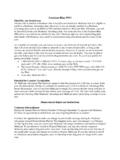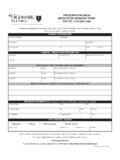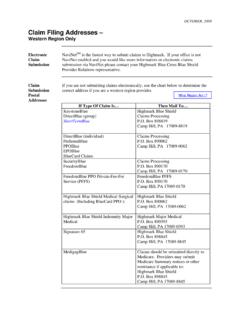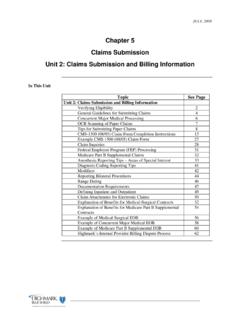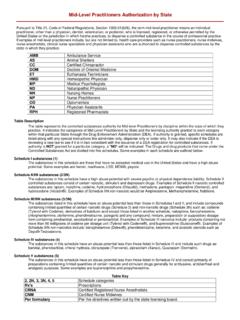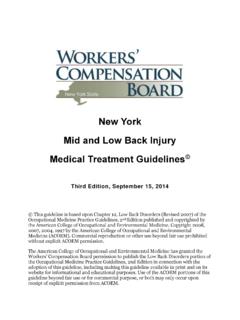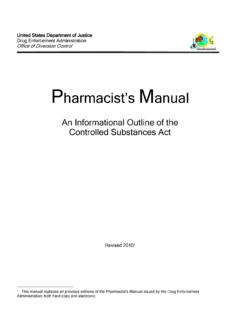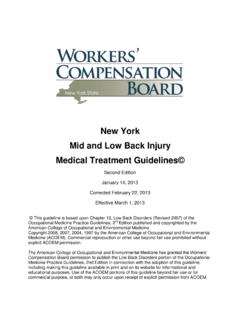Transcription of National Provider Identifier FAQ Q. What is an NPI?
1 National Provider Identifier FAQ Q. What is an NPI? A. An NPI is a 10 digit numerical Identifier for providers of health care services. It is National in scope and unique to the Provider . Whereas in the past, a Provider had a different identification number for each payer, after May 23, 2007, a Provider will have a single Identifier that will be used across all payers. The number itself is not a smart number, , there is no intelligence built into it ( , a phone number is intelligent because starting with area code provides some indication of location). Further, NPIs can be 1 of 2 Types. Type 1 is at the practitioner level, for example, in a group practice, all of the physicians and mid-level providers, , Nurse Practitioners and Physicians Assistants will have their own NPI. In addition, the group itself will have a Type 2 NPI (or more depending on how the group chooses to enumerate). Under certain circumstances, a group could have more than one NPI if it chooses.
2 For example a group with multiple offices or a lab may choose to get a separate Type 2 NPI for each office or ancillary. Q: What is the purpose of NPI? A. The NPI is a single identification number that will be issued by the federal government to health care providers. It is intended to improve the efficiency of the health care system and help to reduce fraud and abuse. Q: Who gets a National Provider Identifier (NPI)? A. NPIs will be assigned to health care providers who need them to submit claims or conduct other transactions specified by HIPAA. A "health care Provider " is defined as an individual, group, or organization that provides medical or other health services or supplies. This includes: physicians and other practitioners physician/practitioner groups institutions such as hospitals laboratories nursing homes dental providers suppliers such as pharmacies and medical supply companies and any health care Provider who transmits any health information in electronic form in connection with a standard transaction.
3 Exception: Health industry workers, such as admissions and billing personnel, housekeeping staff, and orderlies who support the provision of health care are not eligible to obtain NPIs. Page 1 of 8 Q: How do I get an NPI? A. NPIs are issued by the National Plan and Provider Enumeration System NPPES). You may apply for an NPI in one of three ways: Through an easy web-based application process at Through a paper application sent directly to the entity that will be assigning the NPI (the Enumerator). A copy of the application, including the Enumerator's mailing address, is available on You may also call the Enumerator, Fox Systems, for a copy. The phone number is 1-800-465-3203 or TTY 1-800-692-2326. Through a third-party organization, after to whom you have given your permission, may submit an application in an electronic file. This could mean that a professional association or perhaps a health care Provider who is your employer could submit an electronic file containing your information and the information of other health care providers.
4 Q: What is the NPPES? A. The National Plan and Provider Enumeration System (NPPES) has been developed by the Centers for Medicare and Medicaid Services to process applications and assign NPIs. The NPPES will also store information about enumerated providers and apply providers' updates. Q: Will NPIs apply to paper claims as well as to electronic claims? A. The NPI regulation focuses on HIPAA compliant electronic transactions. Payers like Highmark have the option to require NPIs on paper claims. We are currently reviewing this issue. Q: How will NPIs be used? A. The NPI must be used by providers in electronic HIPAA compliant transactions identified, including the 837 (claims submission), the 270/271 (eligibility), the 276/277 (claim status inquiry), and 278 (referral/authorization) to: to identify themselves in HIPAA-compliant health care transactions identify other health care providers in health care transactions In addition, the NPI may be used by providers: to identify themselves on related correspondence to identify other health care providers on related correspondence on prescriptions (the NPI does not replace requirements for the Drug Enforcement Administration number or State license number) The NPI may also be used by: A.
5 Health plans to process transactions and communications with providers B. health plans to coordinate benefits with other health plans Page 2 of 8 C. electronic patient record files to identify treating providers in the medical record D. the Department of Health and Human Services to cross reference providers in fraud and abuse files Q: What numbers will NPI replace? A. It will replace the Highmark Provider Identifier , UPIN, and all other payers' unique Provider numbers. Q: Will a Provider 's NPI ever change? A. In most cases, no. If a health care Provider (for example, a physician) dies, his/her individual NPI will be deactivated. If a Provider goes out of business, the individual NPI will also be deactivated. The deactivated NPI will never be issued to other health care providers. Movement of a Provider from one geographical area of the country to another will not affect his/her NPI. However, if a Provider is part of a group practice that bills using a Type 2 organizational number, that number will change if the Provider leaves a group to join another group.
6 Q: Does the NPI replace the Tax Identification Number (TIN)? A. No. The NPI is not designed to replace the Provider 's TIN, nor is the NPI designed to correspond to the TIN. Q: Is there any relationship between NPI and the Unique Physician Identification Number (UPIN)? A. The NPI will eventually replace the UPIN in the Medicare program. Q: Where can I learn more about the NPI application process? A. Up-to-date information regarding the NPI is available on the NPPES web site at You may also contact the enumerator by telephone at 1-800-465-3203. Q. When does NPI go into effect? A. The deadline for compliance is May 23, 2007. This means that all providers that conduct HIPAA compliant transactions must have applied for and received an NPI by then (and provided that information to payers such as Highmark) and that all payers such as Highmark must be able to process solely on the basis of NPI by then. This means that post May 23, 2007, Highmark will no longer be able to ask a Provider to submit the old Highmark Identifier .
7 Though the deadline is May 23, 2007, providers are already able to apply for and receive an NPI and Highmark will be using a dual strategy while transitioning to NPI based processing. This means that Highmark is accepting NPIs and Highmark Legacy identifiers together on claims submissions currently (both numbers must appear). Highmark is urging all providers to apply for and receive NPIs as soon as possible and to report their NPIs to Highmark as soon as possible. Highmark believes that the earlier that providers apply for and receive an NPI, and the sooner that providers report their NPIs to Page 3 of 8 Highmark, the lower the risk that the transition in May 23, 2007 will result in any confusion or delay in payments. Q. How will Highmark make the transition? A. Highmark is using a strategy called mapping to transition into the NPI world. Highmark will maintain a Provider s current legacy Identifier within its systems. As a Provider notifies Highmark of its NPI, the NPI will be mapped to the legacy number.
8 Internal processing will be done based on the legacy number and all communications will be done on the basis of NPI. Please note, though Highmark will continue to maintain the legacy number (the old numbers that providers used to do business with Highmark, Highmark will be prohibited from using these numbers in communications with providers). The legacy numbers will be hidden and used solely in internal processing. In instances where the NPI cannot be mapped to a unique Highmark legacy number, Highmark will use additional data elements to map the NPI to the appropriate internal Identifier . The primary elements will be taxonomy and service location zip+4 code, and will most likely also include name and degree. It is therefore imperative that providers work with their representatives to ensure that all of these data elements are correctly captured in Highmark s databases and that they are used correctly and consistently in transactions with Highmark.
9 Q. What are some of the complications? A. The transition could potentially be very tricky. Providers have several options on how they will enumerate with NPIs. For example a group with 5 offices may get one Type 2 NPI or five (if it qualifies). If the group opts for one NPI, but currently has five separate Highmark identifiers , then there could be some confusion. As noted in the previous question, Highmark will attempt to map the NPI to the appropriate legacy number internally using taxonomy and zip code. In many cases this will be accomplished with relative ease, in some cases this will prove to be very difficult. This is why Highmark is urging, though it can not require, that providers try to keep the structure of their enumeration as consistent as possible with their existing Highmark structure. In other words if a group practice with five offices has five Legacy Highmark numbers, then that group should try to enumerate with five NPIs whenever possible.
10 Doing so will avoid confusion and potential delay in payments. Q. What does enumeration mean? A. Enumeration basically relates to the number of NPIs a Provider has and the different parts of a Provider that are associated with those NPIs. For example in the past a small hospital may have had three Highmark Legacy Numbers with a different number for the main hospital, an emergency room, and labor and delivery (its Highmark Legacy Enumeration). In the NPI world, the hospital may choose to enumerate in the same manner as it had before (three NPIs, one for each of the three parts mentioned above) or it may, under the regulations, choose to enumerate with a single NPI (one number for the whole hospital regardless of subpart). Page 4 of 8 Highmark is urging, though it cannot require, that providers try to match their existing structure as closely as possible in order to avoid confusion and reduce the risk of delays. In the event that a Provider does not enumerate the same way, Highmark will attempt to map the new structure to the old one internally within Highmark using additional data-elements.


